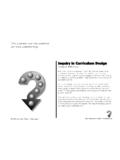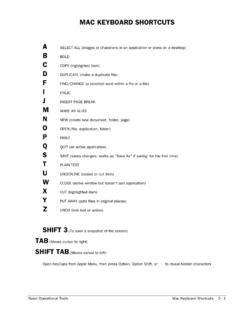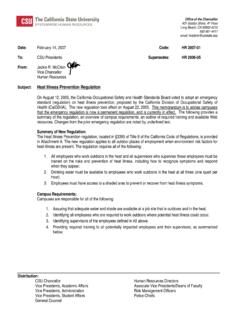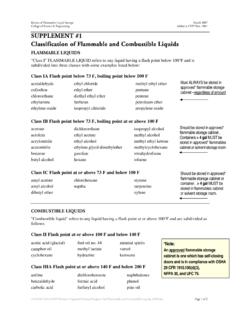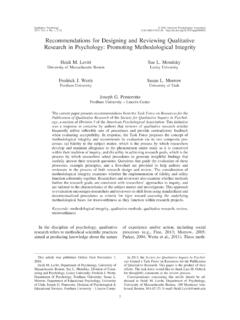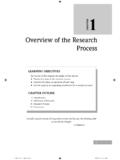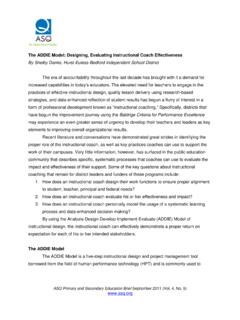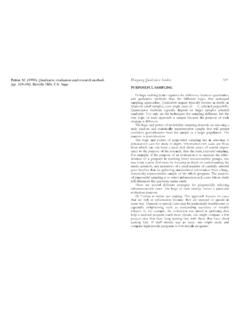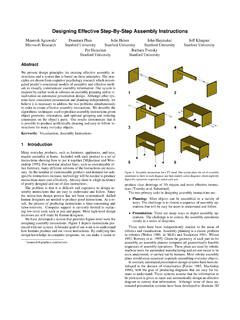Transcription of curriculum design template - San Francisco State University
1 Only a person who has questions can have understanding. Inquiry in curriculum design (October 5, 1999 revision). Inquiry is an activity we engage in every day. We ask questions of ourselves and others in our quest for understanding. In our own inquiries we seek understanding by engaging in daily activities, working on projects, or performing tasks. These are some of the ways we are constantly learning. In curriculum design , teachers can make use of the many forms of inquiry to promote understanding for our students. What questions really engage students? What questions will help frame a course of study? What questions do students want to explore? What content is worth learning? We use the word inquiry when discussing curriculum design to make a slight distinction from other forms of instructional planning. We wish to simply emphasize the importance of questions in the design of learning. When questions are used strategically, they help frame ideas, lead to new ideas, and promote learning.
2 BANDL curriculum design Tools, page 1 Bay Area School Reform Collaborative Unit design Work Sheets & Support Materials Unit design Worksheets Overview Overview of the Planning Process .. 3. Unit design Cover Sheet .. 4. Unit design Blueprint .. 5. Stage 1. Topic Stickie Planning .. 6. What is really important to know? .. 7. Essential Question & Understanding .. 8. Unit Question(s) & Understanding .. 9. Stage 2. Assessment: Determine Acceptable Evidence .. 10. Two Different Approaches To designing Learning .. 11. Collecting Evidence of Understanding .. 12. Construction Of A Performance 13. Construction Of An Academic Prompt .. 14. Scoring Rubrics .. 15. Stage 3. Learning Experiences and Activities (WHERE) .. 16. Learning Experiences and Stickie Planning .. 17. Support Materials Print Resources .. 14. Online Resources .. 15. BANDL curriculum design Tools, page 2 Bay Area School Reform Collaborative An Overview of the Planning Process S.
3 Planning Backwards tage 1 - Identify Desired Results Begin with the end in mind. What should students know, understand, and be able to do? What is worth -Steven Covey understanding? What enduring understandings are desired? There are three big chunks to In this stage we consider our goals and identify the understandings for a unit of study. the design a unit of study. We S. call them the three stages of tage 2 - Determine Acceptable Evidence planning. How will we know if students have achieved the desired results and met the standards? What will we accept as evidence of student understanding and We begin by thinking about the proficiency? end learning goal for students. Planning backwards suggests that we think about a unit or course in terms of the col- What learning will take place as a lected assessment evidence needed to document and validate that the desired learning result of this unit of study?
4 Has been achieved. It is not simply content to be covered or a series of learning activi- ties. This approach helps us develop learning activities for students that are more likely Then we design our assessments to demonstrate their understanding of the material. to align with the learning goals. S. tage 3 - design Learning Experiences and Instruction What prerequisite knowledge and skills will students need in order to perform Finally, we plan instruction and effectively and achieve desired results? Given the performance goals, what classroom experiences for needs to be taught and coached? How will that be done? What materials and re- student learning. sources are best suited to accomplish these goals? Is the overall design coherent and effective? With clearly identified results and appropriate evidence of understanding in mind, it is now time to plan instructional activities. The specifics of instructional planning choices about teaching methods, sequence of lessons, resource materials, etc.
5 Occur after the goals and assessments are is a means to an end. (Grant Wiggins & Jay McTighe, Understanding by design ). BANDL curriculum design Tools, page 3 Bay Area School Reform Collaborative Unit design Cover Sheet nuts & bolts Unit Title Narrative Summary (Write a brief summary for teachers that explains how to incorporate this assignment into their class and why its important. What are the goals of this unit? How are they linked to the essential learnings by design ?). Subject(s). Grade Level(s). Designed by Time Allocation (How long will it take to complete the unit?). School Technology Use (What skills do teachers or students need to use this? How much previous knowledge Standard(s) or familiarity with the use of the Internet and tools are necessary?). BANDL curriculum design Tools, page 4 Bay Area School Reform Collaborative Unit design Blueprint Relevant Standard(s). Questions to focus instruction Essential Question Unit Question(s).
6 Explicit Unit Goals Essential understanding Topic Ideas Unit understanding Skills Evidence of Understanding Description of learning experiences & activities Performance Task(s) (Lessons that hook, engage, are iterative, build skills and organize the content around the Les Lesso unit question(s).). s onn Lesso Les son s onn Lesson Les son s on Other assessments BANDL curriculum design Tools, page 5 Bay Area School Reform Collaborative What ideas or concepts of this topic will you Topic Stickie Planning! focus on in this unit? How does this link to the What will students understand about this topic? standard? what ideas underlie this topic? what issues or dilemmas are involved? what key concepts are part of this topic? Relevant Standard(s). tage 1 - Identify Desired Results What's your big topic idea? S. BANDL curriculum design Tools, page 6 Bay Area School Reform Collaborative What is really important to know?
7 Use stickies to sort, brainstorm, and prioritize what students need to learn. It's worth being familiar with if is really interesting and adds value to the unit tage 1 - Identify Desired Results can be a hook to a big idea is thematic to what is being studied What is worth being familiar with? helps you make links to other ideas or disciplines It is important to know and do if is a key to understanding the subject links to essential understandings What is important is something an adult might need to know & do to know & do? is part of an adult work role needs to be assessed What is the It is an essential understanding if essential goes beyond facts & skills understanding? moves to the heart of the discipline . has value beyond classroom learning is that nugget of learning you might take away forever and S. (Grant Wiggins & Jay McTighe, Understanding by design ). BANDL curriculum design Tools, page 7 Bay Area School Reform Collaborative Essential Question & Understanding Essential understandings represent our personal knowledge at the deepest level.
8 They are complex and central to our lives. It is an understanding that is at the heart of learning. It has value beyond the classroom. It is related to the topic yet transcends discipline-specific learning. rite a declarative statement for the Write an essential question that this unit might address. Consider W essential understanding that will result from teaching the unit. questions that point to big ideas and promote deep and essential understanding. tage 1 - Identify Desired Results Will students remember this for the rest of their lives? Is it an idea that reoccurs across disciplines? S. Does it require ongoing reflection? BANDL curriculum design Tools, page 8 Bay Area School Reform Collaborative Unit Question(s) and Understanding Frame the unit with a question or series of questions State the specific understanding that students will have from the topic in this unit. rite a statement about what students will W understand.
9 State it as a generalization about the content that they will explore in this unit. rite question(s) that W will frame & guide this unit. tage 1 - Identify Desired Results Will it lead students to learn important things? Will it help students develop socially, emotionally and or raise ethical questions? Is it relevant to life outside of school? Can it sustain an engaging inquiry? Does it have many plausible answers? What's most important about this topic? Will it hook the students? S. What do experts know? What meaning should students take away? BANDL curriculum design Tools, page 9 Bay Area School Reform Collaborative Assessment: Determine Acceptable Evidence Stage 2. When teachers use and design classroom-based assessments well, we can assess both content and process. Generally, this form of assessment is more engaging for students. Teachers can use this form of assessment to collect feedback on instruction as well.
10 What are classroom-based assessment tasks? Sometimes we name them performance tasks/projects or they can be academic prompts. These can be long or short student assignments that can open a window into a student's developmental thinking from the beginning to the end of a unit of study. BANDL curriculum design Tools, page 10 Bay Area School Reform Collaborative Two different approaches to designing learning Thinking Like an Assessor Thinking Like an Activity Designer Evidence of understanding Interesting activities What would be sufficient and revealing evidence of un- What would be interesting and engaging activities on derstanding? this topic? Performance tasks Resources & materials What performance tasks must anchor the unit and focus What resources and materials are available on this the instructional work? topic? Know who really understands or doesn't Assignments in and out of class How will I be able to distinguish between those who What will students be doing in and out of class?
